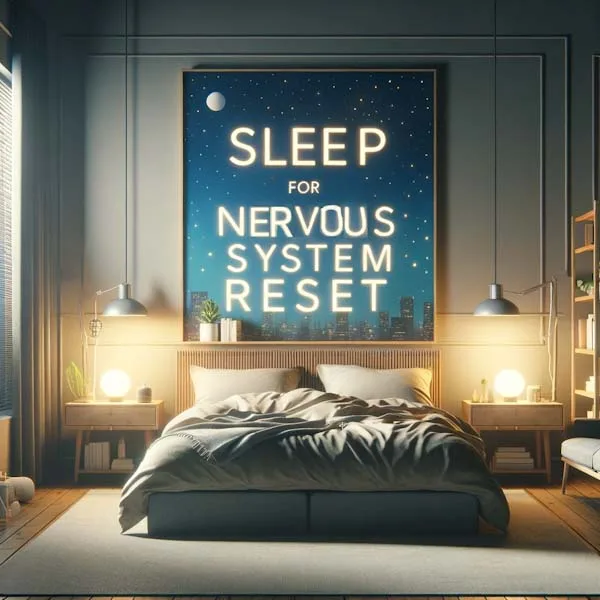Decoding Nervous System Dysregulation: What It Means for You
Nervous system dysregulation is a concept that may sound complex, but it has real, tangible effects on everyday life. It describes a condition where your body’s natural response to stress becomes skewed. Normally, when faced with stress, our nervous system kicks into high gear – this is the activation phase. It’s like pressing the gas pedal in a car when you need to speed up. Once the stressor passes, our system is supposed to shift back to a state of balance, akin to the car returning to a smooth cruise. This balanced state allows our bodies to ‘rest and digest’, effectively recovering from the stress.
However, if your nervous system fails to return to this balanced state, it’s as though the car’s accelerator is stuck, leaving you in a constant state of stress. This lack of regulation means your body doesn’t get the chance to recover properly. The effects can be wide-ranging, impacting your emotional well-being, physical health, and overall quality of life. Understanding nervous system dysregulation is crucial because it’s the first step towards addressing its impacts on your health and well-being. Recognizing this issue can lead you to seek appropriate strategies and interventions to help bring your nervous system back to its optimal functioning state.
Unraveling the Causes: External, Internal, and Emotional Factors

Nervous system dysregulation can be a complex interplay of various factors, each playing its role in unsettling our body’s natural balance. Understanding these causes can help in managing and addressing the dysregulation more effectively.
External Stressors
Life doesn’t always go easy on us, and External Stressors are a testament to that. These are the external events and situations that shake up our nervous system. Trauma is a major player here – it could be anything from an accident to a deeply distressing experience. The environment around us also contributes to this, whether it’s constant noise, light pollution, or even the relentless pace of city living. These external factors act like uninvited guests, overstaying their welcome and disrupting our internal balance.
Internal Factors
Sometimes, the root of the problem lies within. Internal Factors are those intrinsic aspects of ourselves that predispose us to nervous system dysregulation. Genetics play a significant role here. Just as we inherit our eye color or height, we can also inherit a predisposition to certain health conditions that affect our nervous system. Additionally, existing health conditions, whether they’re hormonal imbalances, neurological disorders, or chronic illnesses, can tip the scales against our nervous system’s equilibrium.
Psychological and Emotional Triggers
Our minds are powerful, and so are the Psychological and Emotional Triggers that can cause dysregulation. These are the internal responses to external or internal stimuli, like memories of a traumatic event, ongoing stress at work, or personal struggles. Our emotional reactions to these triggers, such as prolonged anxiety, deep-seated fears, or unresolved grief, can keep our nervous system in a constant state of alert, making it difficult for it to find its way back to a calm and regulated state.
Understanding the root causes of nervous system dysregulation is like having a map in an unfamiliar city. It doesn’t immediately solve the problem, but it certainly makes navigating through it a lot more manageable.
Spotting the Signs: How to Identify Nervous System Dysregulation

When your nervous system is poorly regulated, it can manifest in various aspects of your life, affecting you emotionally, psychologically, physically, and socially.
Emotional and Psychological Impact
Nervous system dysregulation can trigger intense emotional responses, such as overwhelming feelings of shame, guilt, and mood swings. You may encounter fear, panic, aggression, anxiety, rage, and terror. Additionally, feelings of confusion, self-blame, and being overwhelmed are common. Conversely, you might also experience a sense of disconnection, struggling to engage with people or experiences, feeling detached, emotionally numb, and having difficulty in clear thinking or expressing yourself.
Physical Reactions
Physically, you might notice signs of hypervigilance, including insomnia, nightmares, being easily startled, sensitivity to loud noises, trembling, shaking, a racing heart, migraines, digestive issues, and even autoimmune disorders. Tension symptoms are also prevalent, manifesting as teeth grinding, muscle tension, aches, general exhaustion, and chronic fatigue.
Social Dynamics
These symptoms can also influence your social interactions. Attachment issues might arise, leading to unstable or avoidant relationship patterns, fear of abandonment, and either clinginess or a reluctance to spend time alone. In social contexts, you may struggle with boundary issues, social anxiety, irritability, and a tendency to withdraw.
Behavioral Signs
Behaviorally, sleep disturbances and changes in appetite are typical. Difficulties in falling or staying asleep, along with altered eating patterns ranging from loss of appetite to overeating, are indicators of nervous system dysregulation.
Recognizing these symptoms is crucial for addressing nervous system dysregulation. It often involves a mix of therapeutic approaches, lifestyle adjustments, and sometimes medication. Consulting healthcare professionals for a proper assessment and a tailored treatment plan is always recommended. Remember, understanding your symptoms is the first step towards managing them effectively.
Restoring Balance: Effective Strategies to Regulate Your Nervous System
Regaining a sense of balance and calm in our lives is often about grounding ourselves and reconnecting with the present moment. This process is unique and personal, varying greatly from one individual to another.
For some, meditation offers a peaceful retreat, a way to quiet the mind and center the soul. Others might find a similar solace in prayer, a reflective practice providing comfort and perspective. But tranquility can also be found in simpler activities: perhaps tending to a garden, feeling the earth between your fingers, or taking a leisurely walk in the park, where the rhythm of your steps and the gentle hum of nature bring you back to the moment.
Incorporating the below practices into your daily life can be transformative. It’s not merely about creating moments of peace; it’s about fostering a consistent state of calm that enriches your entire being. Over time, this daily commitment evolves into a new way of interacting with yourself, others, and the world.
Mindfulness and Meditation: Breathing Techniques for Emotional Regulation
5-4-3-2-1 Mindfulness

Practices like mindfulness meditation help in focusing on the present moment, reducing rumination and worry. Even a few minutes daily can be beneficial.
The 5-4-3-2-1 Mindfulness technique is a simple and effective grounding exercise that can help regulate the nervous system, especially in moments of stress, anxiety, or sensory overload. This technique works by engaging multiple senses to bring your focus to the present moment, thus helping to calm the mind and body. Here’s how to use it:
Identify 5 Things You Can See: Look around you and notice five things that you can see. Pick something that you don’t usually notice, like a shadow or a small crack in the concrete. Describe the details of these five things in your mind (e.g., their color, texture, or pattern).
Identify 4 Things You Can Feel: Pay attention to the things you can feel physically. This could be the texture of your clothes, the feel of the breeze on your skin, the surface of the chair you are sitting on, or the ground under your feet. Acknowledge these four sensations and describe them to yourself in terms of their temperature, texture, and how they make you feel.
Identify 3 Things You Can Hear: Listen for and identify three things you can hear in the background. This could be the sound of traffic, birds chirping, the hum of a refrigerator, or even the distant sound of conversation. Try to listen to these sounds without labeling or judging them.
Identify 2 Things You Can Smell: Notice something you can smell. It might be difficult if you are not in a place with strong odors, so it’s okay to move around or find something that has a scent, like a flower, a cup of coffee, or a candle. If you can’t immediately smell anything, think of your two favorite smells and remember them.
Identify 1 Thing You Can Taste: Notice the taste that’s in your mouth, or take a sip of a drink, chew gum, or eat something, and focus on the flavors. This step is about being aware of the taste and mouthfeel of what you’re consuming.
Concluding the Exercise: Take a deep breath and notice how your body feels. Acknowledge the calming effect of the exercise. If needed, repeat the exercise or focus longer on one or more of the senses.
This mindfulness exercise is effective for reorienting your attention away from distressing thoughts or feelings and towards what you’re experiencing in the present. It can be particularly helpful in managing symptoms of anxiety, PTSD, or sensory overload, by engaging the parasympathetic nervous system which promotes relaxation and recovery.
Visualization Meditation

Find a quiet space where you won’t be disturbed and get into a comfortable position. Gently close your eyes and draw a deep, measured breath. Breathe in slowly through your nose, allowing your lungs to fill completely, then exhale softly through your mouth.
As you continue to breathe, imagine a soothing white light coming out from your heart. Imagine this light as it spreads, bringing warmth and serenity to every part of your body. While visualizing the white light, lightly rest your hands upon your heart.
Silently repeat the mantra: “I am safe, and I am at peace.” Whisper these words to yourself, letting them echo with each inhale and exhale.
Stay here for a few moments, continuing to breathe deeply while repeating the mantra. When you feel the time is right, slowly open your eyes and ease out of your meditation.
Incorporating this meditation into your routine three times daily – morning, midday, and just before sleep – can greatly amplify its soothing effect on your daily life.
Deep Breathing Exercises

Techniques like diaphragmatic breathing or the 4-7-8 method can calm the nervous system and reduce stress. These involve deep, controlled breathing that helps to relax the body and mind.
The 4-7-8 breathing technique, also known as “relaxing breath,” is a simple yet powerful way to help calm and regulate your nervous system. It can be particularly effective in reducing anxiety, helping you fall asleep, and managing stress responses. Here’s how to do it:
Sit or lie down in a comfortable place where you won’t be disturbed. You can do this technique in any position, but it’s important to keep your back straight if you’re sitting.
Prepare for the Breath: Place the tip of your tongue against the ridge of tissue just behind your upper front teeth, and keep it there throughout the practice. Exhale completely through your mouth, making a whoosh sound.
4-7-8 Breathing Steps: Close your mouth and inhale quietly through your nose to a mental count of four.
Hold your breath for a count of seven. Exhale completely through your mouth, making a whoosh sound, for a count of eight.
Repeat the Cycle: This completes one cycle. Now inhale again and repeat the cycle three more times for a total of four breaths.
Frequency: You can do this breathing technique twice a day. Over time, you can gradually increase the number of cycles, but don’t exceed eight breaths at one time, especially when you’re just starting out.
Focus on the Counting: Concentrate on counting during each phase of the breathing technique. This focus helps keep your mind from wandering and enhances the technique’s relaxation effects.
Remember, the 4-7-8 breathing technique may take some practice. Initially, you might feel a bit lightheaded when practicing; this is common and usually passes with regular practice. The key to its effectiveness is consistency and practice. Over time, this technique can become a powerful tool to help regulate your nervous system and enhance overall relaxation.
The Healing Power of Yoga, Tai Chi, and Muscle Relaxation

Relaxation techniques play a crucial role in improving nervous system regulation by reducing stress and enhancing body awareness. The below relaxation techniques, by reducing stress and improving body awareness, help in balancing the autonomic nervous system, which controls unconscious processes like breathing and heart rate. They teach the body and mind how to respond to stress more effectively, reducing the likelihood of nervous system overstimulation. Over time, regular practice of these activities can lead to a more resilient and well-regulated nervous system, enhancing overall health and well-being.
Yoga combines physical postures, breathing exercises, and meditation to enhance overall well-being. The gentle stretching and muscle engagement in yoga postures help release physical tension, while the breathing techniques (pranayama) promote relaxation and mental clarity. Meditation and mindfulness elements in yoga encourage a focus on the present moment, which can significantly reduce stress and anxiety. Regular yoga practice helps in the activation of the parasympathetic nervous system, which is responsible for the body’s ‘rest and digest’ response, countering the stress-induced ‘fight or flight’ response.
Tai Chi is a form of martial art known for its slow, deliberate movements and deep breathing. This practice is particularly effective in reducing stress and anxiety. The focus on slow, rhythmic movements aids in grounding and centering the mind, which helps in calming the nervous system. Tai Chi also improves balance, flexibility, and muscle strength, contributing to overall physical health, which in turn supports nervous system regulation.
Progressive Muscle Relaxation (PMR) is a technique that involves tensing and then relaxing different muscle groups in the body. This practice helps in recognizing and releasing physical tension that is often held in the body due to stress. By systematically working through the body, PMR can highlight areas of stress that you might not have been consciously aware of. This awareness then allows for targeted relaxation, which can have a soothing effect on the nervous system.
Embracing Nature’s Healing: Realigning Your Nervous System
Make time to connect with nature, experiencing its subtle yet profound impact. Observe the dance of leaves in the wind, or the intricate patterns on tree bark. Listen to the symphony of birdsong, or watch the gentle flow of a nearby stream. Feel the texture of soil or sand under your fingertips, or the warmth of the sun on your face. Nature serves as an intrinsic stabilizer for our nervous system, providing a much-needed “reset.” This natural connection can help realign our mental and physical states, fostering a sense of peace and rejuvenation. By engaging with these elements of the natural world, we can harness their restorative power for our wellbeing.
Beyond the Basics: Additional Strategies to Manage Stress

Time Management: Organize and prioritize your tasks. Breaking down tasks into smaller, manageable steps can reduce the feeling of being overwhelmed.
Setting Realistic Goals: Set achievable goals and be kind to yourself. Recognize your accomplishments, no matter how small.
Practicing Gratitude: Keeping a gratitude journal or simply taking time to acknowledge the positive aspects of your life can shift focus from stressors.
Seeking Professional Help: If stress becomes overwhelming, consider talking to a mental health professional for guidance and support.
Diet, Exercise and Sleep: Key Pillars for Nervous System Health
Nourishing the Nervous System

Diet and nutrition play a crucial role in regulating the nervous system. Making thoughtful changes to your diet can significantly impact your overall neurological health and well-being. Here are some key dietary and nutritional strategies to help regulate your nervous system:
Omega-3 Fatty Acids: Foods rich in omega-3 fatty acids, like fatty fish (salmon, mackerel, sardines), flaxseeds, chia seeds, and walnuts, are excellent for brain health. They help reduce inflammation and have been linked to lower levels of stress and anxiety.
Magnesium-Rich Foods: Magnesium is known for its calming effects on the nervous system. Include magnesium-rich foods like leafy greens (spinach, kale), nuts and seeds, whole grains, and legumes in your diet.
B Vitamins: B vitamins, particularly B6, B9 (folate), and B12, are vital for nerve function and brain health. Sources include lean meats, eggs, dairy products, leafy greens, beans, and whole grains.
Complex Carbohydrates: Complex carbohydrates, found in whole grains, fruits, vegetables, and legumes, help regulate blood sugar levels, which can reduce stress and anxiety. They also promote the production of serotonin, a neurotransmitter that enhances mood.
Antioxidant-Rich Foods: Antioxidants combat oxidative stress, which can negatively impact the nervous system. Berries, nuts, dark chocolate, artichokes, and spices like turmeric and ginger are great choices.
Stay Hydrated: Adequate hydration is essential for maintaining the health of every cell in your body, including those in the nervous system. Aim to drink plenty of water throughout the day.
Limit Caffeine and Alcohol: While moderate caffeine intake can be beneficial, excessive consumption can increase anxiety and disrupt sleep. Similarly, while small amounts of alcohol can be calming, excessive drinking can exacerbate anxiety and depression.
Probiotics and Gut Health: There’s a significant connection between gut health and the nervous system, often referred to as the gut-brain axis. Foods that support gut health, like yogurt, kefir, sauerkraut, and other fermented foods, can positively affect your nervous system.
Herbal Teas: Certain herbal teas like chamomile, lavender, and green tea contain properties that can help soothe the nervous system.
Regular, Balanced Meals: Eating regular, balanced meals helps maintain steady blood sugar levels, reducing mood swings and stress levels.
Exercise and Physical Activity for Emotional Regulation

When our nervous system is dysregulated, or we’re grappling with intense anxiety or stress, our usual faculties of reason and logic can feel out of reach. Movement can help.
Imagine your brain as a multi-story building. At the top, you’ve got the penthouse where logic and reason reside – the newer, sophisticated parts of the brain. But when stress kicks in, the elevator to this penthouse gets stuck. Now, think of the lower floors as the older, foundational parts of the brain. These areas, which control basic functions and emotions, have been around far longer than their fancy upstairs neighbor.
Movement and physical activity are like taking the stairs to these lower levels. It’s here, in these fundamental parts of the brain, where we start the journey of emotional processing and self-regulation. Movement doesn’t just exercise our muscles; it engages these older brain structures, helping to soothe and stabilize our emotions. This isn’t about thinking our way out of a problem; it’s about feeling our way through it.
Exercise plays a multifaceted role in emotional regulation. Physical activity releases endorphins, the ‘feel-good’ hormones that act as natural painkillers and mood elevators. It can also improve sleep patterns, which in turn reduces stress and enhances overall brain function. Regular engagement in physical activity builds not just physical strength, but emotional resilience as well, equipping us to better cope with life’s challenges. Beyond this, exercise increases blood flow to the brain, promoting the growth of new brain cells and connections, which are crucial for cognitive function and emotional well-being.
Moreover, certain activities like yoga or tai chi bring an emphasis on mindfulness and being present in the moment, adding another layer of benefit for emotional regulation. And let’s not overlook the social aspect; group sports or exercise classes provide valuable social interaction, which can be both therapeutic and mood-lifting. The beauty of exercise is its accessibility and variety; it doesn’t have to be intense or time-consuming. Even a brisk walk, a quick stretch, or some light dancing can bring significant benefits.
Sleep Hygiene for Nervous System Reset

Sleep hygiene involves practices and habits that can significantly contribute to a restful and rejuvenating sleep, which is essential for resetting and regulating the nervous system. Here’s a brief guide on how to use sleep hygiene effectively:
Regular Sleep Schedule: Try to go to bed and wake up at the same time every day, even on weekends. This consistency reinforces your body’s sleep-wake cycle.
Optimize Your Sleep Environment: Ensure your bedroom is quiet, dark, and cool. Consider using earplugs, blackout curtains, or a white noise machine if needed. Invest in a comfortable mattress and pillows.
Limit Exposure to Screens Before Bedtime: The blue light emitted by phones, tablets, and computers can interfere with your ability to fall asleep. Try to avoid screens for at least an hour before going to sleep.
Mind Your Diet: Avoid heavy or large meals, caffeine, and alcohol close to bedtime, as they can disrupt sleep.
Establish a Relaxing Pre-Sleep Routine: Engage in calming activities before bed, like reading, taking a warm bath, or practicing relaxation exercises. This can signal to your body that it’s time to wind down.
Physical Activity: Regular physical activity during the day can promote better sleep at night. However, try not to exercise too close to bedtime, as it might energize you.
Manage Stress: Try to resolve your worries or concerns before bedtime. Techniques like journaling, meditation, or gentle yoga can be helpful.
Limit Daytime Naps: If you choose to nap, limit them to about 20-30 minutes and avoid napping late in the day.
Seek Natural Light During the Day: Exposure to natural light during the day helps maintain a healthy sleep-wake cycle.
Don’t Lie in Bed Awake: If you’re not asleep after 20 minutes in bed, get up and do something relaxing until you feel sleepy.
Mindful Information Consumption: Nurturing Your Mental Health

Remember, when you take in information, your nervous system is also absorbing it. It’s important to be aware of your bodily responses to different types of information. Ask yourself: does this information make you feel energized and rejuvenated, or does it leave you feeling drained and anxious? If you notice that certain media triggers anxiety or discomfort, consider disconnecting from those sources. Prioritizing your mental well-being involves being selective about the information you expose yourself to, ensuring it aligns with a state of balance and calm.
As you embark on the path of using these tools for nervous system rebalancing, it’s important to remember the value of small, regular efforts. For many, living with a dysregulated nervous system has been a longstanding reality, so healing, while inevitable, will require patience. Embrace this journey with the understanding that meaningful change happens over time, not overnight. Consistent practice and gentle perseverance are your allies in this process of gradual healing and restoration.
Cultivating Relationships: Strengthening Emotional Well-Being

Good social relationships are more than just fulfilling; they actively contribute to our nervous system’s ability to self-regulate. The regular practice of co-regulation with friends, family, or support groups can be a powerful way to receive emotional support and gain fresh perspectives on life’s challenges.
Engaging in simple, everyday interactions with supportive people plays a crucial role in maintaining our psychological balance. The value of casual chats, small talk, and shared experiences like meals, coffee breaks, or walks should not be underestimated. These moments of connection can have a profound impact on our emotional well-being.
However, it’s important to be discerning about who we spend our time with, especially when seeking to restore nervous system regulation. A good rule of thumb is to reflect on how you feel after being with someone. We’ve all had experiences where certain interactions leave us feeling drained or unsettled. Like tending to a garden, it’s beneficial to minimize contact with those who negatively affect our well-being and instead focus on relationships that uplift and support us.
If you find your social network lacking, remember that positive interactions can also come from health professionals like massage therapists, counselors, coaches, psychologists, or psychiatrists. Consulting with religious or spiritual leaders, engaging in prayer, or exploring religious and spiritual texts can also offer comfort and perspective.
Building and maintaining a supportive social environment is a continuous process, akin to nurturing a garden. It requires patience, effort, and sometimes the wisdom to know what needs pruning. By fostering healthy relationships and seeking out positive interactions, we lay the foundation for a well-regulated nervous system and a balanced emotional state.
Towards a Balanced Self: Embracing the Journey of Regulation
Navigating the complexities of nervous system dysregulation requires a multifaceted approach. From understanding its causes and recognizing its varied symptoms to employing effective strategies like mindfulness, breathing exercises, relaxation techniques, and lifestyle changes, we can find our path to balance and well-being. Remember, the journey to a regulated nervous system is gradual and personal. By incorporating these practices into our daily lives and being mindful of our interactions and environments, we can foster resilience, stability, and harmony within ourselves. It’s a continuous process of learning, adapting, and nurturing our mental and physical health.
